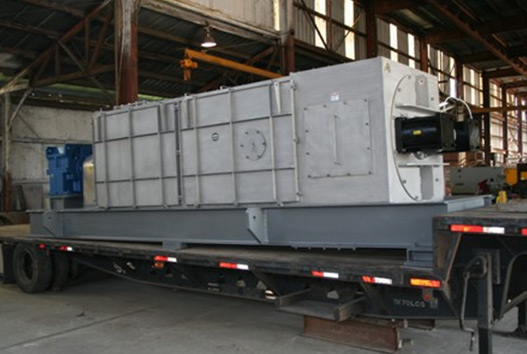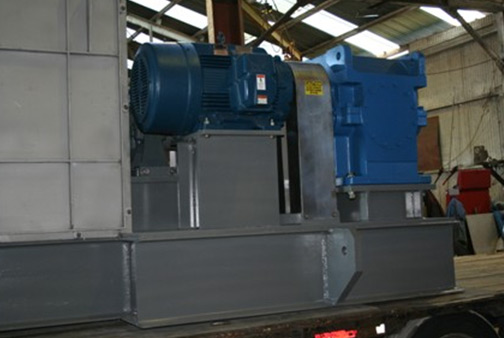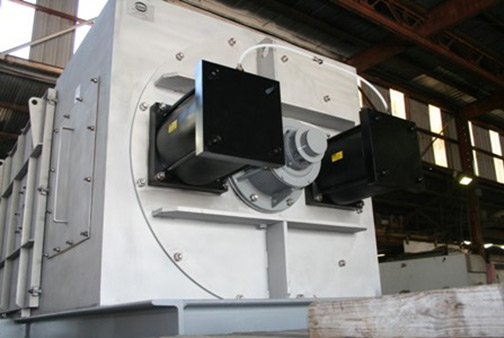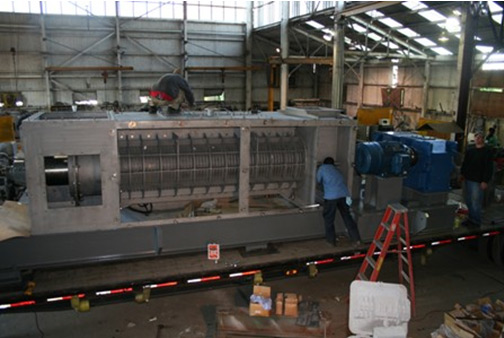Rev. September 2012
Vincent has screw presses in Holland, Israel, France, China, Russia, and the United States in an alcohol washing process. The process is used to produce protein concentrate from soybeans.
Following harvest, vegetable oil is extracted from soybeans. This is done by flaking the beans and then running them through a solvent extraction process. A final step involves low heat hexane removal systems of “flash desolventizing” or “Down Draft Desolventizing”, which leave an oil-free and hexane-free material. This material is known as “white flake”. (Vincent is not involved in any part of this industrial process.)
SPC (Soybean Protein Concentrate) can be separated from white flake. The solubles (mainly sugars) in the white flake are removed (diffused) through washing with aqueous alcohol. Vincent screw presses remove as much of the remaining alcohol, water, and sugar as possible. Finally the product is run through desolventizing equipment to remove all traces of alcohol and to reduce the moisture to around 8%. The product produced in this manner, SPC, is rich in protein.
The screw presses used in this application are special. Since the soybean material performs much like sawdust or ground corncob, very low press cake moisture (in the range of 50% to 56%) can be achieved. However, it takes more horsepower than normal, and an unusual screw is required in the press. This screw design was developed by Daniel Chajuss of Hayes General Technology Company, a pioneer in the industry.
Furthermore, because of the alcohol that is present, the machines are made in an explosion-proof configuration. Bolted vapor tight covers are used throughout. Under safety codes, V-belt drives cannot be used, so in-line drives are necessary. As a result, vapor tight presses are longer than normal.
European ATEX (“Atmosphères Explosibles”) standards for vapor-tight presses have required the addition of features such as the use of RTD’s (resistance temperature detectors) and ATEX certified motors and gearboxes. Vincent presses meet these requirements.
In the 1900’s, most SPC presses were Model VP-16’s. These are used for processing 50 metric tons per day (MTPD) of white flake, which results in an output of 1.5 metric tons per hour (MTPH) of SPC. More recently, the wider adoption of SPC as an animal feed, especially for commercially grown fish, has led to the use of Model VP-24 presses. These will handle 100 MTPD of SPC or more. Larger scale projects are being designed which are likely to use twin screw presses in order to achieve the higher capacity requirements.
Originally SPC was used primarily as a premium ingredient in the food processing industry. Because of its blandness, palatability, and freedom from deleterious and antigenic components, as well as its ability to take flavorings, it is used to extend, and substitute for, many foods. It is used in meat, poultry, fish and milk products. It is also important as a milk replacement in feed for calves and piglets, as well as being used in pet foods. Soy protein concentrate is used in powder, textured, and highly functional and soluble “refolded” forms.
A by-product of this process is a molasses. When the alcohol is recovered from the press liquor of the screw press, there is residual water and sugars. This flow is concentrated in an evaporator, producing molasses suitable for animal feed.
This is an unusual market niche in which Vincent has specialized. While we are experts on the screw presses that are required, we refer broader technical inquiries to Hayes General Technology in Israel.
 |
 |
|
MODEL VP-30 SCREW PRESS — VAPOR TIGHT CONFIGURATION |
|
 |
 |
